New York is famous for its rich avifauna – there are over 500 bird species there with a number of those being very active during the night!
Examples of nocturnal birds in New York include the barred owl, common nighthawk, American woodcock, eastern whip-poor-will, barn owl, and many others.
Do some of them sound familiar? Let’s jump in and see what each of these looks and sounds like!
Table of Contents
Night Birds In New York
1. American Woodcock

- Scientific Name: Scolopax minor
American woodcocks are unique and elusive birds found in fields and clearings adjacent to young forests, particularly those with some scattered cover. These small shorebirds are found throughout New York during the summer breeding season.
The best time to observe them is during dawn and dusk, for about 45 minutes after sunset and before sunrise. When searching for woodcocks, focus on fields next to forests, with powerline cuts being excellent spots to target.
Because of their nocturnal lifestyle, inconspicuous colors, and low-profile behaviors, American woodcocks are usually very hard to spot.
You can recognize them by their distinctive “peent” call which is given from the ground or the twittering that can be heard from the air.
American Woodcock Call | Source: Jonathon Jongsma, CC BY-SA 3.0, via Wikimedia Commons
2. Wilson’s Snipe
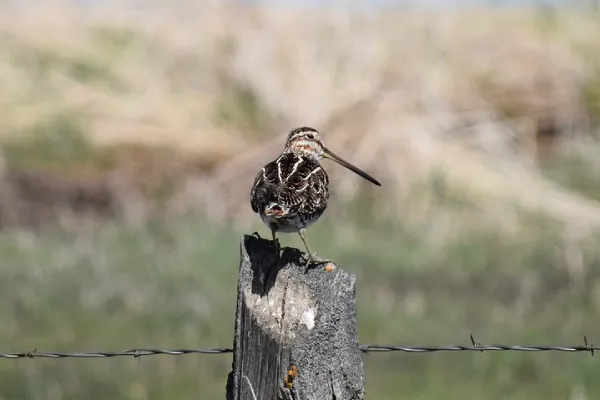
- Scientific Name: Gallinago delicata
Much like American woodcocks, Wilson’s snipes prefer wet grassy fields, sedge marshes, and bogs. They are also summer residents in NY and their activity peaks during dawn and dusk.
To locate them, listen for their “tuk-tuk” call, which can be heard from the ground or low perches. Their winnowing display flight is distinctive and can be heard overhead, with a longer duration compared to woodcock display flights.
Wilson’s Snipe Call | Source: Doug Hynes, CC BY-SA 4.0, via Wikimedia Commons
Males will fly high in circles and then take shallow dives to produce a distinctive sound. This behavior can be spotted during the day and long into the night.
3. Eastern Screech-Owl

- Scientific Name: Megascops asio
Eastern screech owls are small and stocky owls with big heads, large yellow eyes, often-raised small ear tufts, and horn-colored beaks. Out of all North American owls, they are the most strictly nocturnal.
Eastern Screech-Owls are permanent residents of New York typically found in woodlands, especially near water and at lower elevations.
They are most vocal close to sunset and become quieter as the night progresses. Their calls are more frequent around full moons and before storms. Key calls to listen for include the characteristic “whinny” and trilling tremolo calls. In June-August, keep an ear out for juvenile hissing sounds.
Eastern Screech-owl Call | Source: Jonathon Jongsma, CC BY-SA 3.0, via Wikimedia Commons
4. Great Horned Owl

- Scientific Name: Bubo virginianus
Great horned owls are one of the biggest birds in New York. They measure almost 2 feet long, weigh up to 3.5 pounds, and can be found throughout the year in the state.
These owls prefer open areas like fields and marshes near mature forests. They become most vocal for an hour after dark and an hour before dawn.
Great Horned Owl Call | Source: Michael & Katie LaTour, CC BY-SA 4.0, via Wikimedia Commons
In winter or spring, they often sing in a duet. In summer, the distinctive juvenile begging call can sometimes be confused with the calls of the rare barn owl.
5. Barn Owl
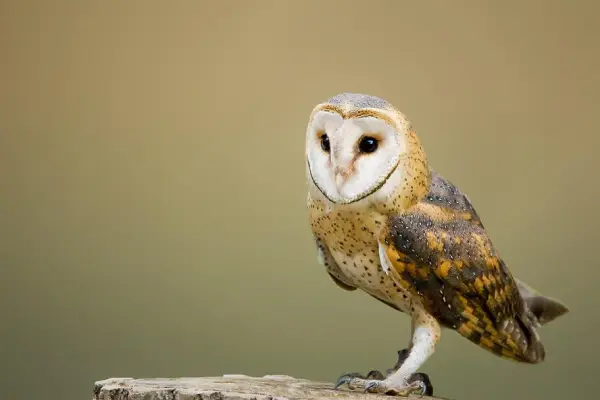
- Scientific Name: Tyto alba
Barn owls are highly elusive raptors and one of the most widely distributed species of owl in the world. However, in New York, they only reach the northern limit of their range. Barn owls are considered rare in the state and have experienced a concerning decline over the past two decades.
They are secondary cavity-nesting birds, meaning they often use pre-existing openings for nesting. They can be found breeding in open habitats, including grasslands, marshes, and agricultural areas.
Their most known nesting areas in New York are concentrated on Long Island and Staten Island, particularly within the Coastal Lowlands region, where nest boxes have become a critical component for their conservation.
These medium-sized owls have a “ghostly” appearance due to their heart-shaped heads, cinnamon and gray upperparts, and white underparts. Barn owls hunt for rodents during the night; they do not hoot but make bone-chilling screams instead.
Barn Owl Call | Source: Luis Gracia, CC BY-SA 4.0, via Wikimedia Commons
6. Barred Owl
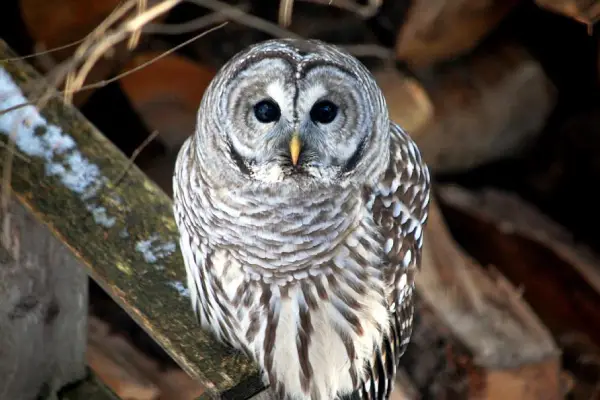
- Scientific Name: Strix varia
Barred owls are year-round residents of New York, commonly found in dense deciduous or mixed forests, particularly near water.
They are active throughout the night and are known for their “who-cooks-for-you” song and “hoo-ahhh” call. They will duet, and their juveniles make a high-pitched raspy hissing noise, an automatic confirmation if it’s heard in a specific block.
Barred Owl Call | Source: Jonathon Jongsma, CC BY-SA 4.0, via Wikimedia Commons
These massive owls with mottled brown and white plumage can be also identified by their yellow beaks and absence of ear tufts.
7. Long-eared Owl
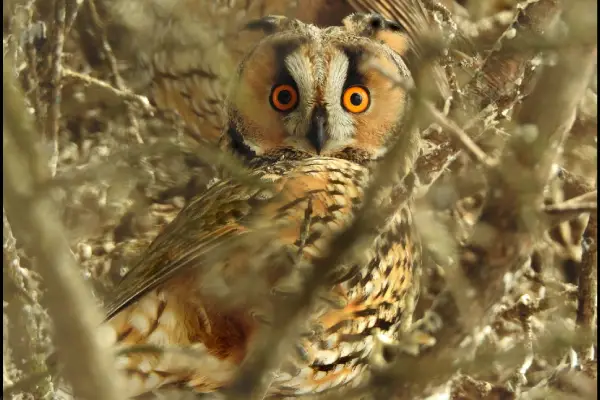
- Scientific Name: Asio otus
Long-eared owls are elusive birds that can be found in open forests, marshy areas, and dense coniferous woods. These secretive, nocturnal, and well-camouflaged owls have gray-brown bodies with pale bars and heavy streaks on their underparts.
They become active shortly after dusk throughout the night. Long-eared owls don’t vocalize often but have distinct calls. The male’s song is a low-pitched series of “hoo” notes, similar to the sound of blowing across a bottle.
Long-eared Owl Call | Source: Alexander Kurthy, CC BY-SA 4.0, via Wikimedia Commons
The distinctive juvenile begging call is also a good indicator, but caution is needed as distant barking dogs or mooing cows can sound like long-eared owls.
Read More: Examples of night birds found in Michigan
8. Northern Saw-whet Owl

- Scientific Name: Aegolius acadicus
Northern saw-whet owls are mottled brown with white-spotted heads, whitish facial disks, yellow eyes, and lack of ear tufts. They are year-round residents found throughout New York.
What makes their flight feathers unique is the compound called porphyrin – the pigment gives their feathers a neon pink fluorescence when exposed to UV light.
Northern saw-whet owls were named after their loud and repetitive whistles that are described as “a saw being sharpened on a whetstone”.
Listen for the tooting advertising song of males, a repeated “toot-toot-toot.” They give a variety of other calls, and later in the season, juveniles produce a raspy, hissing call.
Northern Saw-whet Owl Call
These owls prefer swamps with red maple and tamarack trees, as well as forests with many snags, ideally coniferous. Their calling peaks around 2 hours after sunset and decreases until just before sunrise.
Read More: What birds sing at night in Indiana?
9. Pied-billed Grebe

- Scientific Name: Podilymbus podiceps
Pied-billed grebes are small, stocky, and short-necked water birds found throughout the Americas. They are breeding residents in NY and can be identified by their brown plumage that gets darker on the crown and back. Such colors serve as great camouflage but make it harder to spot them.
These birds are commonly found in marshes and ponds with emergent vegetation and are active throughout the night. Listen for their loud, whooping, cuckoo-like song, with pairs sometimes singing together in a duet.
Pied-billed Grebe Call
Read More: List of most common birds found in New York City
10. Common Nighthawk

- Scientific Name: Chordeiles minor
These medium-sized birds with forked tails and long, pointed wings are crepuscular and nocturnal raptors found throughout New York during the summer breeding season.
Common nighthawks are common in prairies, forests, savannahs, and urban areas, and are active during dawn and dusk with a visible moon. They produce a distinct peent sound and engage in courtship displays with rapid dives creating a booming sound as air passes over wings.
Common Nighthawk Call | Source: Unknown author, Public domain, via Wikimedia Commons
Keep in mind that common nighthawks are well-camouflaged and blend with the environment during the day. Their plumage is usually gray, black, and brown with white wing patches close to the base of primary feathers.
Read More: Examples of night birds of Massachusetts
11. Chuck-will’s-widow
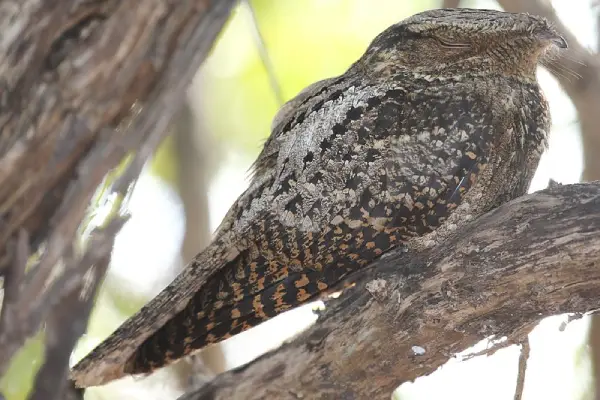
- Scientific Name: Antrostomus carolinensis
Chuck-will’s-widows are large night birds with big heads, short bills, and long tails. Their plumage varies from grayish to rufous with intricate patterns, camouflaging them well in the trees.
Chuck-will’s-widows are found in pine barrens and edges of swamps. They sing “chuck-will’s-widow” songs, with males being most active in April-May, quieter in June, and more vocal again in July and August. Singing may continue all night on days of a full or near-full moon.
Chuck-will’s-widow Call | Source: James G. Howes, Public domain, via Wikimedia Commons
You might have spotted them in your headlights while driving as they love to sit on the roads and roadsides at night.
They are also common in Virginia; read about the other birds found there on this link.
12. Eastern Whip-poor-will
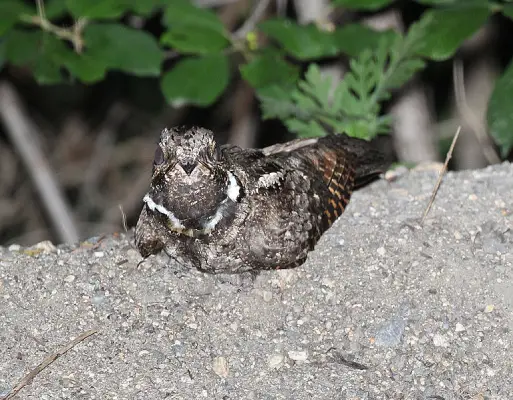
- Scientific Name: Antrostomus vociferus
Eastern whip-poor-wills can be seen throughout New York during the breeding season. They have mottled plumage with a mixture of brown, black, and gray that camouflages them well with their environment.
These cryptic nocturnal birds are easier to hear than to see as they remain motionless and sleep during the day. Look for them around pine barrens and forest openings where they sing their namesake “whip-poor-will” song.
Eastern whip-poor-will Call | Source: G. McGrane, Public domain, via Wikimedia Commons
They hunt at night, feeding on flying insects they catch from the ground. Eastern whip-poor-wills closely resemble common nighthawks – the two can be differentiated by their behavior and characteristic call.
They are also active at night in South Carolina; read about other night birds found there in this article.
13. Virginia Rail

- Scientific Name: Rallus limicola
Virginia rails are compact aquatic birds characterized by their brown plumage, which is notably darker on their backs and crowns. They also possess distinctive orange-brown legs and bills.
Virginia rails can be heard any time of day or night around wetlands with cattails. They often make harsh “kuk-kuk-kuk” calls during the night; their “grunt” calls can be used for communication between mates.
Virginia Rail Call
To navigate dense vegetation, they have developed a body with lateral compression and robust forehead feathers that can withstand the abrasion of pushing through the thick growth. Very secretive by nature, they are more often heard than seen.
Read More: List of nocturnal birds in Florida
14. Sora

- Scientific Name: Porzana carolina
Soras are small waterbirds found throughout New York. They are breeding residents in the state and can be identified by their short yellow beaks, dark-marked brown upperparts, blue-gray faces and underparts, and black and white barrings on the flanks.
Soras are common around wetlands containing cattails and patches of open water; their descending “whinny” call is used by mated pairs and when establishing territories. They also have a “ker-wee” call for attracting mates and are most active during dawn and dusk.
Sora Call | Source: Jonathon Jongsma, CC BY-SA 3.0, via Wikimedia Commons
Read More: What birds sing at night in Georgia?
15. Clapper Rail

- Scientific Name: Rallus crepitans
Clapper rails are large brown birds found along the Atlantic coasts of the eastern United States, eastern Mexico, and some Caribbean islands. These chicken-sized birds rarely fly and have grayish-brown plumage with orange bills that curve downwards.
These birds inhabit saltmarshes, and you can listen to the male’s repeated “kek” calls in marshes on Long Island. They also have grunt or “clapper” calls that pairs use to communicate.
Clapper Rail Call
Clapper rails have 4-16 creamy white eggs with brownish blotches that both parents incubate; males will incubate them at night.
Read More: What birds sing at night in Texas?
16. Common Gallinule

- Scientific Name: Gallinula galeata
Common gallinules are medium-sized marsh birds with small heads, thin necks, small bills, and long legs and toes. Notice their dark plumage with white undertails and red frontal plates on their heads.
Common gallinules are found in freshwater wetlands with open water and emergent vegetation. Listen for the ‘marsh chicken sound‘ and single ‘clucks,’ which are the most frequently heard sounds.
Common Gallinule Call
They are mostly active at dawn, secondarily at dusk, and rarely at night.
Read More: Examples of nocturnal birds of Louisiana
17. American Coot
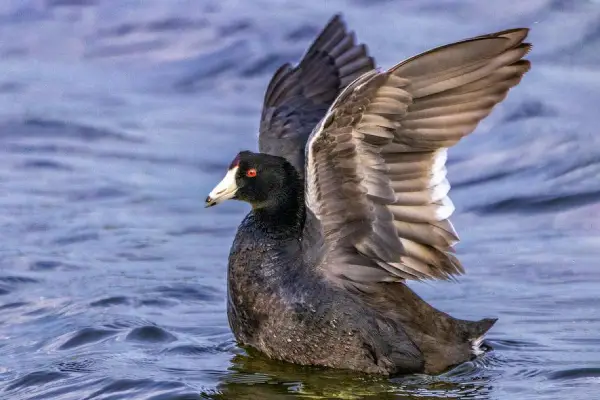
- Scientific Name: Fulica americana
American coots are small chickenlike waterbirds with black plumage, bright white beaks, red eyes, and yellow-green legs. They also have rounded heads, sloping foreheads, short wings and tails, and large feet.
Although they resemble ducks, American coots are only distantly related to them. These summer residents of New York can be seen in freshwater wetlands with open water and emergent vegetation.
They produce a sharp “poot” call and a screeching “kree” sound, and they are particularly noisy swimmers, so you may recognize them by splashing water sounds. They are most active around dawn and dusk.
American Coot Call
Further Reading: List of night birds of Alabama
18. American Bittern

- Scientific Name: Botaurus lentiginosus
American bitterns are wading birds from the heron family. These well-camouflaged solitary brown birds breed in the state before departing south for the winter. They are mainly nocturnal with most of the activity happening around dusk.
These birds prefer large cattail or sedge marshes and wet meadows. More often heard than seen, American bitterns have a distinctive booming call that resembles a congested pump that people describe as “oong-kach-oonk.“
American Bittern Call | Source: Alejandro Erickson, CC BY-SA 3.0, via Wikimedia Commons
Read More: What are some common nocturnal birds heard in Ohio?
19. Least Bittern

- Scientific Name: Ixobrychus exilis
Least bitterns are one of the smallest heron species in the world. They are common in NY during summer and can be identified by their long legs, daggerlike bills, and orange-black-and-white plumage.
Least bitterns are common around marshes with a mix of open water and vegetation, often with cattails, phragmites, or lily pads. Males can be recognized by their soft “coo-coo-coo” and “reek-reek-reek” calls.
Least Bittern Call | Source: Niels Krabbe, CC BY-SA 3.0, via Wikimedia Commons
They are more active at dawn and dusk and less vocal in windy or rainy conditions.
Read More: Most common night birds in Oklahoma
20. Northern Mockingbird
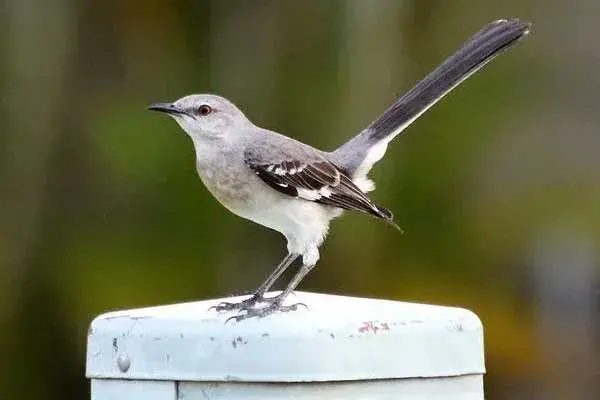
- Scientific name: Mimus polyglottos
Northern mockingbirds are the most commonly heard at night in New York, with the nighttime singers often being young, unattached males or older males without mates. In well-lit areas, even mated males may sing at night.
To reduce their constant (and obnoxious) singing, you can use bird nets on trees or set up cardboard cutouts of predators like hawks or owls.
These birds are year-round residents in the state, and their translated Latin name, “many-tongued mimic,” is well-deserved. They can imitate over 35 species and learn more than 200 songs in their lifetime!
Their mimicry extends to sounds like rusty hinges, car alarms, cackling hens, and dog barks, often indistinguishable from the real thing.
Northern Mockingbird Call | Source: Sandtouch Limited Company, a Texas limited liability company, CC BY 3.0, via Wikimedia Commons
Read More: List of night birds in North Carolina
What Birds Sing At Night In New York?
The most common birds that sing at night in New York are Northern mockingbirds.
Mockingbirds singing all night are often young, unattached males or older males without a mate. In case you want to stop their nighttime singing, try to cover your tree with bird netting or add an owl/hawk cardboard cutout to scare them away.
Read More: What birds sing at night in Tennessee?
Summary
New York’s rich avifauna is brimming with nocturnal birds. Some can be seen year-round there, like several owl species, while others, like common nighthawks, American woodcocks, and Wilson’s snipes visit the state only to breed.
In case you’ve stumbled upon or heard any of these birds, we hope this guide helped you identify which ones they were.
Feel free to read our other popular articles on birds that have white spots on their plumage and birds that sing at night in Oregon